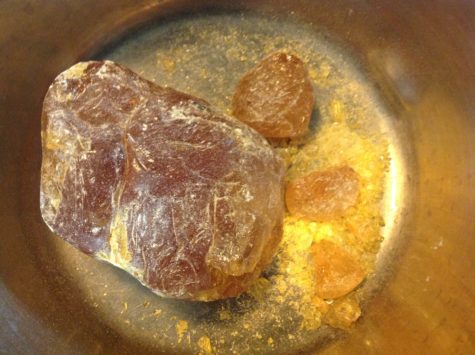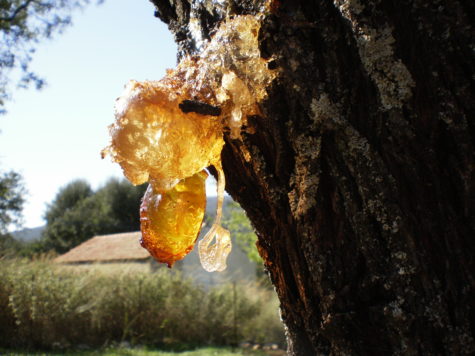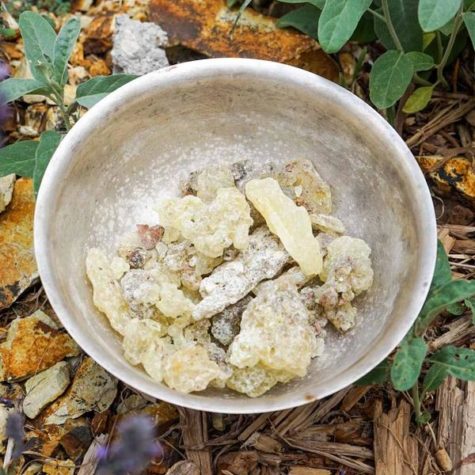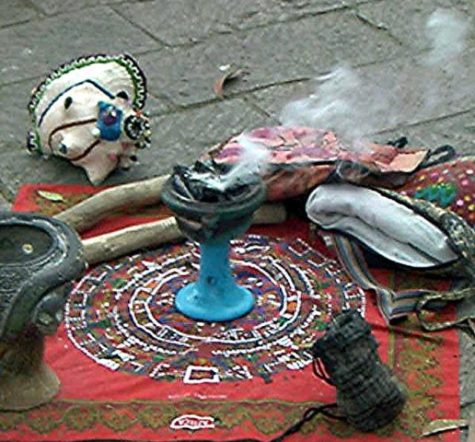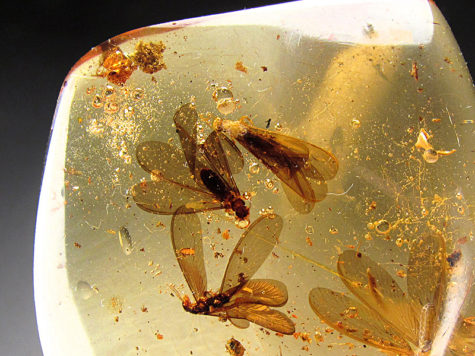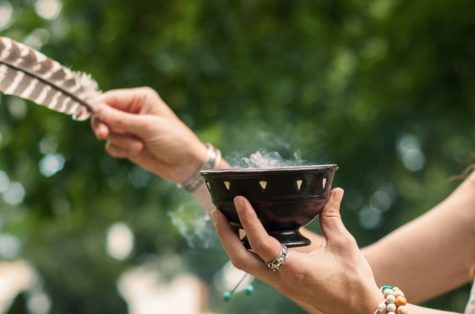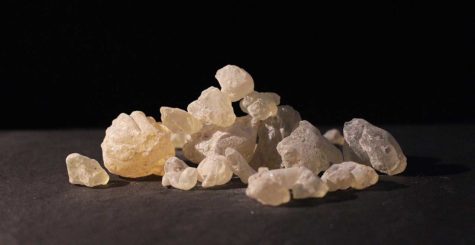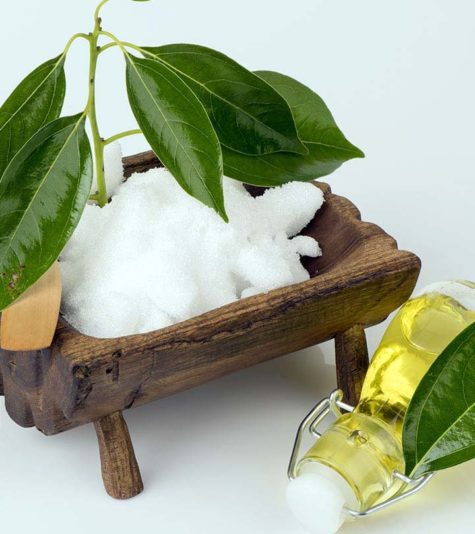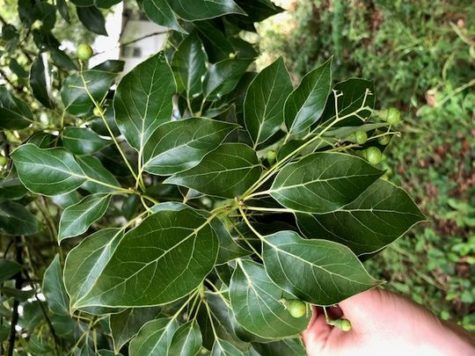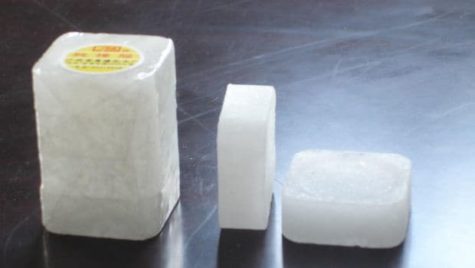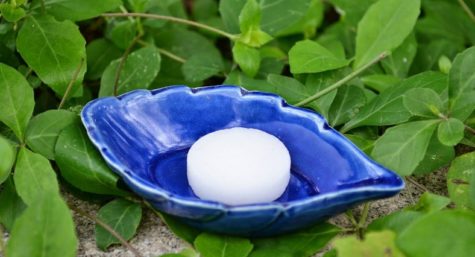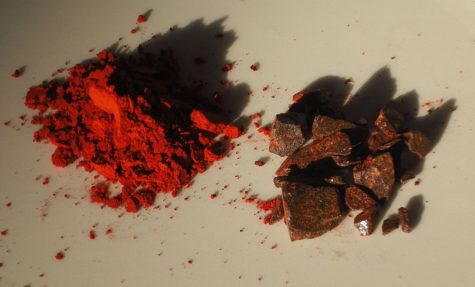Resin and Insence
- Ruler: Sun, Solar Deities
- Type: Tree resin
- Magickal Form: Beads, Tears
- Magical properties: Inspiration, Attraction, Invocation, Happiness, Celebration, Contact with astral planes and Exorcism.
- Burn for: Protection, Cleansing, Purification, To promote spirituality, To purify quartz crystals and other stones before use in magic.
Copal is a resin from a tree that is indigenous to Mexico, Guatamala and elsewhere in Central America. It is particularly identified with the aromatic resins used by the cultures of pre-Columbian Mesoamerica as ceremonially burned incense.
Copal is burned on a charcoal tablet, to enhance consecration, spell craft, exorcisms and banishings. It can also be powdered and added to other herbs to focus their energies and lend power. You can also get Copal incense, which is powdered copal in stick form.
Copal is still used by a number of indigenous peoples of Mexico and Central America as an incense and during sweat lodge ceremonies.
About Copal:
Copal is a natural tree resin that is between two states—it is neither a hardened resin nor sap. Copal resin comes from trees in the Buresa family, which is considered a medicinal tree to the Mayas in southern Mexico.
Several species of Central American trees produce resins known as Copal. In Mexico, a species of pitchy pine, Pinus pseudostrobus, is sometimes called Copal, but in Guatemala today (and historically among the ancient Maya) Copal is a resin from plants in the same Burseraceae family as Middle-Eastern Frankincense and Myrrh. These medicinal trees are traditionally used for clearing the body of diseases and also to keep mosquitos away.
Since ancient times, Copal incense has been considered sacred to the people of Mexico, as well as South and Central America. It goes as far back to the Mayan and Aztec cultures. Mass amounts of Copal resin were burned atop the Aztec and Mayan pyramids as offerings to the gods and deities. In the Mayan ruins, Copal was discovered in the burial grounds, proving its spiritual significance.
Copal Varieties and Variations:
Several varieties of Copal are recognized in historic and modern markets in Central and North America, partly based on what plant the resin came from, but also on the harvesting and processing method used.
- Golden Copal resembles Frankincense, being pale-colored, granular, and lightly fragranced.
- Black Copal is dark, heavily-scented and similar to Myrrh.
- White Copal is the more expensive version, also known as Moon Copal.
Wild Copal, also called gum or stone Copal, exudes naturally as a result of invasive insect attacks through the bark of the tree, as greyish drops which serve to plug the holes. Harvesters use a curved knife to cut or scrape the fresh drops off the bark, which are combined into a soft round glob. Other layers of gum are added on until the desired shape and size is achieved. The external layer is then smoothed or polished and subjected to heat to enhance the adhesive properties and consolidate the mass.
The favored type of Copal is white Copal (Copal blanco or “the saint”, “penca” or agave leaf Copal), and it is obtained by making diagonal cuts through the bark into the trunk or branches of a tree. The milky sap flows along the channel of the cuts down the tree to a container (an agave or aloe leaf or a gourd) placed at the foot. The sap hardens in the shape of its container and brought to market without further processing.
According to Hispanic records, this form of the resin was used as an Aztec tribute, and pochteca traders transported from the outlying subject provinces to Tenochtitlan. Every 80 days, so it was said, 8,000 packages of wild Copal wrapped in maize leaves and 400 baskets of white Copal in bars were brought into Tenochtitlan as part of a tribute payment.
Copal oro (gold Copal) is resin which is obtained by the complete removal of the bark of a tree; and Copal negro (black Copal) is said to be obtained from beating the bark.
Black Copal is favored by rural people for their worship services and is usually sold in the form of substantial disks or balls which are burned on a bed of charcoal.
Copal often has inclusions and is sometimes sold as “young amber.” Sometimes insects will become trapped within the resin, just as they sometimes are found in amber. Copal is easily distinguished from genuine amber by its lighter citrine color, and its surface will become tacky with the application of a drop of acetone.
Magickal Uses:
Copal is popular in magical, healing and spiritual uses. It makes a great meditation incense and increases psychic insight. Inhaling its aroma is said to enhance the powers of clairvoyance. It is also used to provide systematic oracles.
- Divination spells that use Copal can be found here: Divination
Copal is added to many love, exorcism and purification incenses. It’s an important ingredient in many rituals. A piece of Copal can represent the heart in poppets. Many churches use this incense before their ceremonies.
Copal, is a “holy incense,” and can be can used for consecration and anointing of pentacles, athames, wands, etc. by passing these objects through its smoke. It can be burned when one is seeking “divine favors”. Like most resins, Copal is burned or smoldered as an incense during spellwork and/or rituals and needs to be burned on charcoal tablets or discs.
Copal makes for an excellent smudge and is commonly used in sweat lodge ceremonial gatherings. This is a wonderful resin to work with and for creating a mellow, magickal atmosphere to work in.
- A recipe for a Copal Ritual Wash can be found here: Magickal Apothecary
Burn this incense for purification and to contact the spirits of the dead. Mexican churches burn Copal on the Day of the Dead to help the souls of the deceased reconnect with their loved ones on the earth plane.
In its native Guatemala, Copal is a holy incense burned when seeking divine favor. Saint statues and other sacred items are blessed by smoking them in Copal. Passing seed corn through the smoke from Copal that was dressed in sacrificial blood before being burned is said to increase its viability and productivity.
Copal is used by the Maya to induce trances and in rites of divination, such as one where fourteen grains of corn are passed through the smoke, then cast on the ground, and the patterns they make are read to foretell the future.
In the US, Christians recite the 23rd Psalm while burning Copal or speak aloud their gratitude for blessings received.
Copal may also be used to draw attention from the opposite sex.
- Carry a piece of Copal in your pocket or in a charm bag especially when the opportunity to meet someone arises.
- Make a “path of seduction” by sprinkling Copal powder to create an aura of romance.
Grind a lump of Copal into powder using a mortar and pestle, visualizing your desires coming true while you’re grinding. Then either burn the powder, or carry the powder with you inside a locket worn around your neck.
It can be used to ward off negative energy by placing small pieces of Copal in with your crystals and then kept in a special place of your choice or wearing around your neck as a magickal sachet. A “sachet of protection” can be made with a combination of Copal, Frankincense, and Myrrh.
It is said that the familiar scent of White Copal helps the souls find their way back during their annual visit home, which is why this resin often burned during spirit workings and Beltane and Samhain rituals. For purification, spirit and ancestral workings, White Copal also is used to induce concentration and mental clarity. A beautiful resin to bring about peace and happiness.
Copal incense is a wonderful energy tool to use during your meditations. It is linked with the crown chakra, deepening your awareness and encouraging pure thoughts during meditation. Copal also helps to strengthen the auric body, removing all energy blockages. It is particularly useful in times of stress or even for alleviating feelings of depression, because it helps you to shift your mindset.
The burning of Copal is believed to call upon the God Tlaloc and the goddess Chalchiuhtlicue. Both of these dieties were associated with fertility and creation. You can light Copal incense as an offering to this God and Goddess, if you feel connected to their energy. Lighting the incense in their honor will invite them into your space and allow you to tap into the power of creation.
The Metaphysical Properties of Copal:
“Real” amber is millions of years old; but there is also another form of amber, young amber. Copal is a very young form of amber. Real amber is wonderful, but it does have that huge age behind it, experience and wisdom which makes it a little difficult to deal with for beginners, and a lot more expensive on your pocket.
Copal, on the other hand, is YOUNG, and that is the operative word and importance of using Copal in magic charms and potions.
It is still far more alive in many ways, far closer to our own states of being as it is on its road into the many millions of years that are its future. Copal offers a bridge between us now, and the infinity of time where our souls reside.
The young Copal is friendlier, lighter and brighter; and together with the absolute healing/protection of all resin and amber, this YOUTH is what reacts with the energy system of a human being and brings re-charging as well as that expectation of eternal life at the same time.
Copal unites the energizing force of the sun with the grounding, transmutive properties of earth. A powerful yet gentle healer and cleanser, Copal draws out and transmutes negative energy of all kinds on all levels. Copal aids in physical self-healing, emotional healing of depression, and environmental clearing.
Created out of tree blood, its very life force, the material trees use to heal themselves, Copal is a healing treasure. It heals physically, emotionally, and environmentally, clearing and cleansing all negativity and illness that exists around it. It is a powerful yet gentle healer, drawing out negative energy and bringing positivity. This gem dispels disease, revitalizing tissue and encouraging physical regeneration.
Copal opens and cleanses all of the chakras. Highly protective, Copal also aids in the manifestation of ideas to reality. The life force trapped within Copal promotes fertility, and its protective and environmental clearing properties make it a good stone to use to prepare a healing or birthing room.
Copal strengthens the Meridians, and helps to keep us grounded so that we can speak from the heart. It also strengthens our control over our minds. Use Copal with the Solar Plexus Chakra to increase confidence, mental clarity, and creative self expression. A chunk of Copal is perfect for your pocket or for selected energy work.
With the life force of eras long past, Copal links the everyday self to the higher spiritual reality. It aids in manifestation, its electromagnetic properties attracting what it is you focus on. Use pieces of Copal in your manifestation grids or rituals.
Copal for Purification:
Copal incense is completely natural incense that is used to purify the energy of spaces, places and objects. It has a clean, light, woody scent that could be compared to pine or turpentine. One of the best Copal uses is burning it to clear away all the negative energy and make positive changes. It brings a very positive and loving energy that will fill your home with peaceful energies.
Try one of these cleansing methods:
- To cleanse your healing crystal jewelry
Hold the piece and allow it to fully submerge in the smoke. You may notice the jewelry moving in a circle or back and forth. Keep it in the smoke until all movement stops.
- For cleaning crystals:
If you’re using Copal incense for cleaning crystals, hold the crystal in the smoke for a few seconds, rotating it so the smoke bathes all sides of the crystal.
- For clearing spaces:
To cleanse a space, allow the Copal incense to fill the room. If you have a feather fan, encourage the smoke to rise into the corners of the room.
Sources:
- Ruler: Moon, Buddha
- Type: Extract from tree
- Magickal Form: Oil, whole chunks
Note: Camphor is the resin of an Asiatic tree. It is a natural moth repellent and should not be confused with toxic naphthalene moth balls, which are merely scented with Camphor. When it comes to the essential oils, only essential oil of white camphor is safe for use.
Camphor is a substance frequently taken for granted. It’s used in many lotions and cosmetics because of the cooling sensation it provides. Camphor, botanically related to cinnamon, is considered a sacred lunar plant. In Marco Polo’s time it was bartered for with gold. It is one of the seven substances most sacred to Buddha and meditation upon it, or in its presence, will bring enlightenment.
Obtained from the evergreen tree, this fragrant white compound holds many spiritual properties. In voodoo rituals, it is burned for love and attraction. It is one of the most sacred substances to offer to the moon goddess on a new moon to thank her for her abundant blessings.
Camphor is also used in cleansing and purification rituals. White camphor oil added to the bath also clears the thoughts and soothes the soul.
Camphor allegedly reduces sexual desire. Use it to get rid of unwanted passions or unwanted admirers. Burn camphor or add one or two drops of essential oil of white camphor (other forms are toxic) to your bath when you need to cool off. Endeavor a would-be lover to smell camphor if he or she is forcing their attentions on you and you are not interested. It will instantly turn him or her off.
Burned on charcoal, Camphor is said to cleanse the home. It may be blended with other incenses for this purpose. The scent of burning camphor purifies a space and brings self-discipline, aiding in controlling and transforming bad habits. Long used in the Eastern Hemisphere for temple purification and protection, camphor is excellent for deep meditation and gaining insight. A little goes a long way, so if you burn camphor on charcoal, use only a small pinch.
Camphor resin is sold in small squares, four to a pack. Those who do not wish to burn incense place one square in each corner of a room, or crumble a single square into a bottle, cover it with Florida Water, and leave the bottle open to spiritually cleanse the room.
During the days of the polio epidemics, mothers hung camphor balls around children’s necks to ward away illness. This spell works under the same premises, except that what you’re warding off is the metaphysical virus of an unwanted romantic attention, or to ward off illness, negativity, or whatever you would like to repel.
Here’s how:
Dip a cotton ball in essential oil of white camphor and keep it in your pocket or tucked into a bra. Alternatively, you could hang it around your neck.
NOTE: Be sure not to use any other variety of camphor. Only essential oil of white camphor is safe for use.
Camphor is under the dominion of the moon. The lunar palace of Lady Chang’O is allegedly crafted from cinnamon wood, however both true cinnamon and camphor derive from trees of the Cinnamonium family. Maybe the Moon Lady’s palace was actually built from camphor wood.
Because of this connection, camphor can transmit some of the moon’s protective and luck drawing powers. Here’s how:
Charge spring water with lunar energies by filling a white, blue, or silver container with clear spring water and then leaving it in a windowsill or outdoors on a full moon night. The next day, dissolve a camphor square into the lunar-charged spring water.
Use this water to cleanse appropriate magical tools so that they may be used to fulfill your wishes and be imbued with the power of the moon.
NOTE: Be careful, camphor can also be toxic.
From:
- Element Encyclopedia of 5000 Spells
- The Encyclopedia of Magickal Ingredients
- The Herbal Alchemist’s Handbook
- Other Names: Blood Palm, Sangre de Dragon
- Element: Fire
- Planet: Mars
- Parts Used: Resin – powdered or in chunks
- Basic Powers: Energy, Purification, Protection
Dragon’s blood is not the blood of some luckless lizard, but the resin of the palm calimus draco. Truly as red as the blood of dragons, this resin is a powerful herb of protection. Burned by itself on charcoal or added to other incense ingredients, it quickly banishes any negative energy or entity. Dragon’s blood also adds power and potency to any working.
- Use sparingly in an oil blend or in the bath – it will stain enamel scarlet and leave a stain on the skin.
Magically it is used for spells of protection, exorcism and sexual potency. On its own Dragon’s blood can be burnt at an open window to secure a lover’s return, and a piece of the resin placed under the mattress is said to cure impotence. In the past Dragon’s Blood was used medicinally to cure diarrhea, dysentery and even syphilis. Like many other resins it is also used to stop bleeding wounds.
Gravel-sized chunks and powdered Dragon’s Blood may be burned on charcoal. Folks claim that this cleanses the home and rids the premises of evil. It is said to be particularly good when moving into a new home, and may be mixed with Camphor resin for this purpose.
Add a pinch of the ground herb to incenses to increase their potency and effectiveness. Add to love incenses and sachets.
You can create your own pure dragon’s blood oil by crushing the resin into a powder and mixing in a light oil, such as safflower. Heat gently to melt the resin into the oil while stirring. Do not ingest.
Varieties and Variations:
A great degree of confusion existed for the ancients in regard to the source and identity of dragon’s blood. Some medieval encyclopedias claimed its source as the literal blood of elephants and dragons who had perished in mortal combat.
The resin of Dracaena species, “true” dragon’s blood, and the very poisonous mineral cinnabar (mercury sulfide) were often confused by the ancient Romans. In ancient China, little or no distinction was made among the types of dragon’s blood from the different species.
Both Dracaena and Daemonorops resins are still often marketed today as dragon’s blood, with little or no distinction being made between the plant sources; however, the resin obtained from Daemonorops has become the most commonly sold type in modern times, often in the form of large balls of resin.
Voyagers to the Canary Islands in the 15th century obtained dragon’s blood as dried garnet-red drops from Dracaena draco, a tree native to the Canary Islands and Morocco. The resin is exuded from its wounded trunk or branches. Dragon’s blood is also obtained by the same method from Dracaena cinnabari, which is endemic to the island of Socotra. This resin was traded to ancient Europe via the Incense Road.
Dragon’s blood resin is also produced from the rattan palms of the genus Daemonorops of the Indonesian islands and known there as jerang or djerang. It is gathered by breaking off the layer of red resin encasing the unripe fruit of the rattan. The collected resin is then rolled into solid balls before being sold.
Sangre de Dragon, more commonly know as Dragon’s Blood, is a wild crafted resin that comes from the Croton Uechleri trees found in the Amazon Rainforest of South America. The heart shaped leaves and the blood-like red sap speak to the abilities of this beautiful tree to heal wounds and cleanse the blood. The Flowers found high in the branches resemble the dragon’s head, thus the interesting name, as well as a symbol of its fierce healing ability.
Collected from various sources
